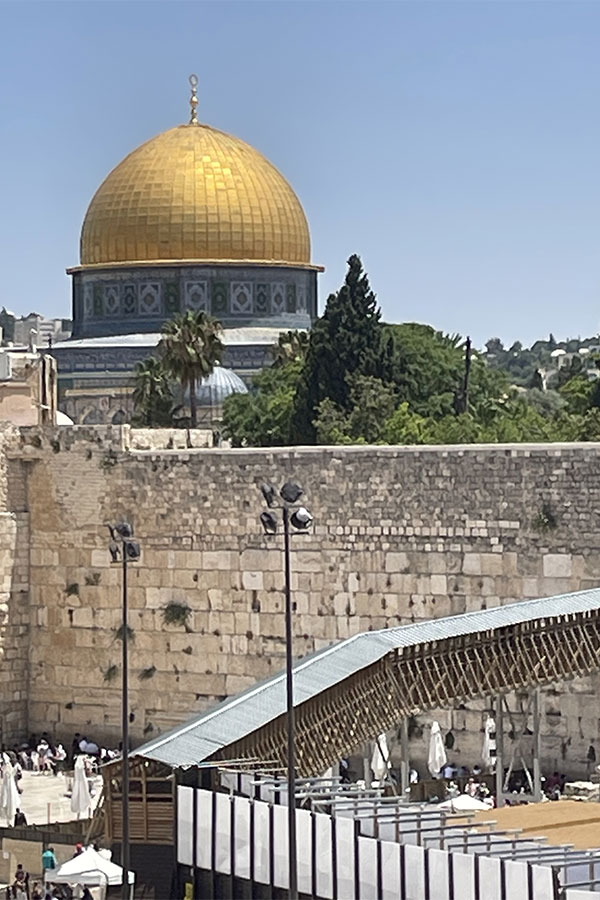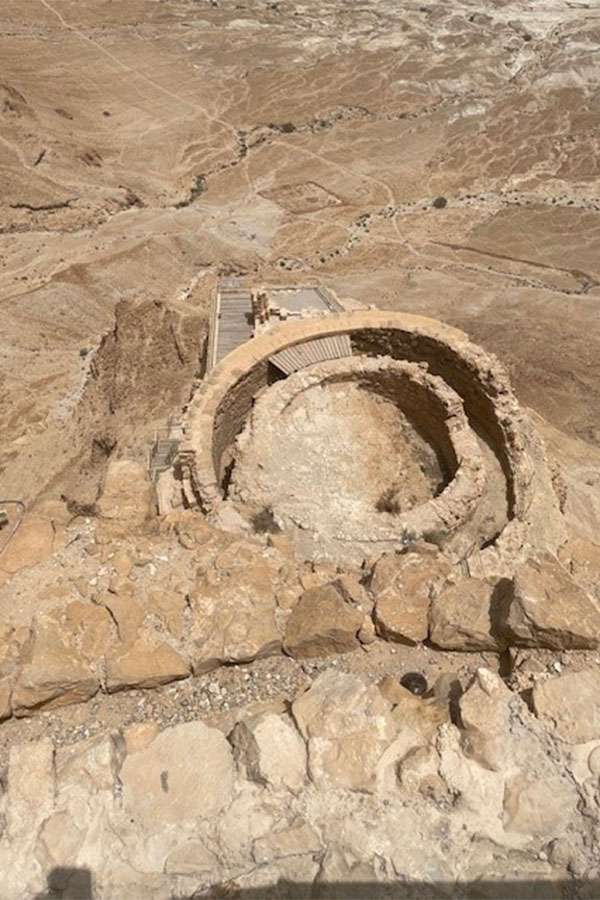A five-day stay gave me a brief introduction to this country that deserves a much longer look.
Jerusalem




The Western Wall is one I’d long had an image of in my mind, from photos and TV programmes. However, nothing had quite prepared me for the reality. With a vast open plaza before it, and separate sides for men and women, it is a totally extraordinary place. So much smaller than I’d imagined and clearly a place of immense spiritual importance for the Jews praying, touching and staring at it. People sat reciting long Hebrew prayers, some stood gently rocking and others slipped pieces of paper into the spaces between the ancient stones. I don’t think I’ve ever been somewhere that’s felt so religiously important to believers before.
The Western Wall is a portion of the ancient limestone wall in the Old City of Jerusalem that forms part of the larger retaining wall of the hill known to Jews and Christians as the Temple Mount. It is the only relic of the Second Temple that was demolished by the Romans in 70 CE and is considered by Jews to be the Wall located nearest to the utterly sacred Holy of Holies. As we left the plaza, we caught a glimpse of the shining golden roofed Dome of the Rock, sacred as a shrine to Muslims though built on the site of the Second Temple so a place of extreme contention at times.
We meandered through a narrow maze of streets, that brought to mind Marrakech, to eat lunch – falafel, pitta and salad – outside at an Arab-owned restaurant. And then to the Church of the Holy Sepulchre. Another full-on religious experience – this time for Christians – as it’s considered to be the holiest place of pilgrimage being the purported site of the crucifixion and tomb of Christ. It is a remarkable church, shared by the Roman Catholic, Greek Orthodox and Armenian Apostolic, Coptic, Syriac, and Ethiopian Orthodox churches, each having a specific area or chapel in the building. It was busy, filled with pilgrims and tourists, affording little space for quiet reflection sadly. That said, there was extreme devotion on many faces, amid the flickering candles.
This city needs a few days at least to explore and to make sense of. It is a living city though, I had been worried it might somehow be a giant museum.
Yad Vashem – The World Holocaust Remembrance Center
This is another powerful impactful place, just four miles outside Jerusalem, with exhibitions, a synagogue, remembrance spaces and dedicated gardens. Maybe that’s what Israel is – a intense collection of religiously significant sites, ancient and new, that seem to insist on a response whoever you are and whatever you believe.
The grounds and gardens at Yad Vashem are stunning: causing contemplation and thoughtfulness. Trees, shrubs and the design honour all those lost. The Avenue of the Righteous Among the Nations remembers non-Jews who risked, and at times lost, their lives protecting Jews. Trees have been planted in their memory with their names shown on plaques.
The Holocaust History Museum tells stories, of individuals, communities and countries. There are no punches pulled, no attempt at easing the difficulty at the seeing the exhibits and reading the information. Stark black and white images, abandoned children’s shoes and toys alongside the words of Holocaust survivors take you way beyond the broad political questions of ‘why’ and ‘how’ to deeply personal individual experiences. It is Anne Frank many, many times magnified.
The Hall of Remembrance, an uncomplicated building, dark inside with a flame lit for each of the 22 ‘Nazi murder sites’ to quote the Yad Vashem website, is hauntingly simple and impossible to ignore.
We came away with the words ‘lest we forget’ having gained an extra, weighty dimension.
Nazareth



A busy town, that is very hilly and doesn’t appear to relate to the sat nav! It’s also home to Israel’s largest community of Israeli Arabs, 30% of them Christian. Although there’s a strong Palestinian influence here as we found when wandering through a very quiet souk area, with flags on display and a community café offering cultural activities, into which we were warmly welcomed.
As across most of the country, we were a bit taken aback by the fact that people of all three Abrahamic faiths seem to co-exist tolerantly. Of course, there are real and serious issues but in Nazareth and much of Israel this wasn’t apparent to us at least. Day to day life appeared pretty harmonious.
We were there to visit the Church of the Annunciation, as were many others. It’s a modern building, competed in 1969, built on the site of previous churches, going back to the 3rd or 4th century CE. At the lower level is the Grotto of the Annunciation, believed to be the childhood home of Mary, Christ’s mother. Services are occasionally held here at a modern alter, with the opening to the ancient grotto visible. The church itself and outdoor gallery is a colourful celebration of the Madonna – stunning images and mosaics from endless countries worldwide depict their particular vision of Mary. This international cooperation alone makes it a unique place.
Masada


You can walk up to the hilltop fortress, it takes just an hour I’m told but in 37C heat, I decided the cable car up was a good option. Situated in southern Israel, a place of retreat when life got rather heated (wars, usurpers, revolutions) in Jerusalem, two palaces were built by Herod the Great for himself on the mountain which were fortified between 37 and 31 BCE. Situated at the end of a high plateau on the edge of a steep cliff, the views across the land below, it’s mainly desert, stretching to the Dead Sea, are outstanding. It is one of Israel’s top tourist attractions.
It is a place of great archaeological significance and a tour around the ruins gives fascinating detail into the organisation of the fort – water courses, food storage and Herod’s pleasure pavilions. Its religious importance comes from the siege of Masada by Roman troops from 73 to 74 CE, at the end of the First Jewish–Roman War, which ended in the mass suicide of the 960 Jewish rebels who were hiding there. There has been some doubt cast on the evidence for this event, however it certainly is considered the truth by many tourists who visit. As it was for the young boys we saw celebrating their bar mitzvah here.
The Dead Sea

Just 12 miles or so from Masada, this is actually a hypersaline lake, the deepest and lowest (over 430 metres below sea level) on earth. Animals and plants cannot live in this environment, thus the name.
To visit is an experience. Top tip, be sure to take waterproof beach shoes because it’s a long hot walk from the changing rooms to the water and the seabed, even by the shore, is rocky and uneven, with slipppy mud underfoot. We visited the public section of the Dead Sea, on land it’s a bit like an old-fashioned beach resort. People having picnics, sunbathing and enjoying a jolly day out. With donkey rides replaced by camel rides.
We changed and walked down the steps to immerse ourselves. You really do float: the instructions are clear – on your back only and do not get the water in your mouth or eyes. It’s a bizarre feeling, liberating in a way and so much more real than a flotation tank in Wokingham which is the nearest I’ve got to the feeling before. And then the mud, which, when packaged, sanitised and sold as skin-enhancing products costs a fortune, is freely available to scoop up from the seabed and plaster over yourself. You let it dry and hey presto, your skin does indeed feel smooth and firmer. There’s a queue to stand under the hose to wash the mud off, with busy showers in the changing rooms for a final thorough scrub.
There’s not an iota of body shame here: I’ve never seen so many shapes and sizes of the human form, from across the globe, in a variety of swimsuits, from all encompassing to barely visible at all. And amid the many languages I heard, all the faces registered pleasure and surprise at being in those famous waters, with free mud endlessly available.
Personal Thought
Given how much one hears in the news, the endless negative reports and the challenging images, I wasn’t sure what to expect despite friends and family telling me what a fascinating place Israel is to visit. I was conflicted about going however I’m happy to say that it is truly wonderful, with some less comfortable undertones, which can’t be ignored. I’ll go back again for further explorations.
Next steps
To plan and book at tour of Israel, and many other countries, go to McCabe Travel.
Jennie was a guest of Sar-el Tours, McCabe’s local guides in Israel, who provided an excellent service, with informative, lively guides and modern air-conditioned coaches or minibuses.












2 Responses
What an interesting article … it has definitely prompted me to want to go.
Thanks Pennie. Yes, a fascinating place and certainly worth a visit